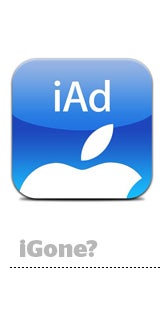 If Apple is indeed shifting its iAd platform to focus on direct deals, as BuzzFeed reported Wednesday, it means its experiment accepting programmatic demand has come to an end after little more than a year.
If Apple is indeed shifting its iAd platform to focus on direct deals, as BuzzFeed reported Wednesday, it means its experiment accepting programmatic demand has come to an end after little more than a year.
Perhaps it was inevitable. While Rubicon Project, Accordant Media and MediaMath were among iAd’s programmatic partners, not much happened after that deal was inked.
At the time, industry experts figured programmatic demand would fix iAd’s biggest problem, which was that it was expensive, but it seems a bigger problem did iAd in: the dearth of data.
“The lack of flexibility to utilize data severely hamstrung our ability to take advantage of the key benefits it provided in terms of reach and premium inventory,” said Jim Caruso, SVP of product and client strategy at Varick Media Management.
iAd also didn’t have cross-device functionalities, Caruso said, further putting it at a disadvantage compared to other mobile ad companies.
Plus, iAd operated as a blind network, which wasn’t good enough for many brands that want a specific publisher list, said Keith Petri, VP of strategic partnerships at IgnitionOne. He also noted it didn’t pass latitude-longitude information, only more general DMAs [designated market areas].
When Apple opened iAd up programmatic demand, it touted 400 targeting parameters as well as validated registration data via iTunes, but those features appear not to have helped buyers. Because Apple made this data available in a walled garden environment, it would have limited the ability for advertisers to tag and track campaigns and export insights.
The DSP ChoiceStream never worked with iAd, CEO Eric Bosco said, because of its data limitations. “For us, the ability to be able to look at campaigns holistically, and access [an individual on] mobile supply and tie back to the same individual on desktop supply, is the core of what we do. iAd just didn’t fit into that model for us.”
Putting out a campaign via iAd also required making custom creative to their specs, which added another hurdle to making iAd part of an ad campaign.
‘The creative tools were very slick, but nothing groundbreaking,” Caruso said. They had limited use because “they were only integrated to push to iAd, while we often run across many channels and platforms.”
The Publisher Side of iAd
App publishers who used iAd have plenty of other options to serve ads – for instance, connecting directly with iAd’s programmatic partners.
“An app developer integrated with only one SSP would be atypical, besides a small app developer with one app with low users,” Petri said. Because iAd is easy to install, many publishers have it in their stack, but it becomes less important in revenue once they bring on demand sources like Twitter’s MoPub or Google’s Admob.
Apple possibly kept the direct sales line open for iAd publishers because Apple News inventory is served through iAd. Those publishers now must sell direct.
The Future Of iAd
If iAd is stepping back from bringing in programmatic demand, could this be iAd regrouping or is it the beginning of the end for an ad platform first formed out of Apple’s acquisition of Quattro Wireless in 2010?
Signs point to the latter.
“You’ve had [Apple CEO] Tim Cook on record saying that Apple’s core positioning is one around data privacy and protecting consumers,” Bosco said. “The rest of the world is turning to much more data-driven approaches to advertising. Here is a company publicly planting the stake and saying they want no part of it.”
He noted that Apple has made it “harder and harder to target Safari on iOS,” another sign that iAd goes against Apple’s position on privacy.
At least one person in ad tech saw this coming. “I think there’s a 95% chance it’s a bad idea for Apple,” MediaMath CEO Joe Zawadzki told AdExchanger back in 2010 when the company bought Quattro and entered the ad business.
Apple did not respond to a request to comment in time for publication.














